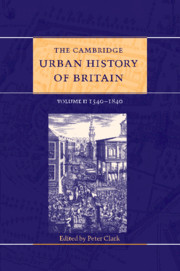Book contents
- Frontmatter
- 1 Introduction
- Part I Area surveys 1540–1840
- Introduction
- 2(a) England: East Anglia
- 2(b) England: South-East
- 2(c) England: South-West
- 2(d) England: Midlands
- 2(e) England: North
- 3 Wales
- 4 Scotland
- Part II Urban themes and types 1540–1700
- Part III Urban themes and types 1700–1840
- Select Bibliography
- Index
- References
2(a) - England: East Anglia
from Part I - Area surveys 1540–1840
Published online by Cambridge University Press: 28 March 2008
- Frontmatter
- 1 Introduction
- Part I Area surveys 1540–1840
- Introduction
- 2(a) England: East Anglia
- 2(b) England: South-East
- 2(c) England: South-West
- 2(d) England: Midlands
- 2(e) England: North
- 3 Wales
- 4 Scotland
- Part II Urban themes and types 1540–1700
- Part III Urban themes and types 1700–1840
- Select Bibliography
- Index
- References
Summary
regions in England have never been closely defined; and urban regions even less so. Cultural identities have been forged locally – in streets, villages, parishes, townships, counties – and also nationally or even, at times, imperially. Moreover, suspicious central governments have always refused to designate formal provincial capitals. That has been the case over many centuries. As a result, regional boundaries in England resist tidy mapping and English towns have never been constrained within distinctly designated regional networks.
Yet there have also existed some broad historical affiliations that were greater than the shire counties and less than the nation. Thus were generated England’s ‘regions of the mind’. In concept, these were permeable and mutable, their boundaries and significance varying over time. But, by virtue of their popular origins, they had a shadowy survivability. They drew not upon formal administrative structure but upon shared geography, experience and culture. In addition, the long-term persistence of urban networks often encouraged these ‘regions of the mind’, since communal identities were forged when people met together – and the towns provided the classic meeting places, where residents and travellers congregated for commerce, conviviality and conversation.
EAST ANGLIA AND REGIONALITY
East Anglia existed regionally in this way. Its boundaries were not rigid. It was not recognised by government as an administrative region and hence had no official provincial capital. Its ‘broad’ speech was fused from a variety of dialects. Moreover, its local economy was not homogeneous. And it certainly was not cut off from the wider world.
- Type
- Chapter
- Information
- The Cambridge Urban History of Britain , pp. 31 - 48Publisher: Cambridge University PressPrint publication year: 2000



